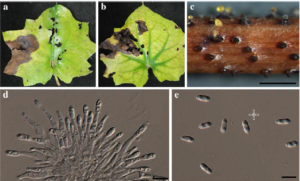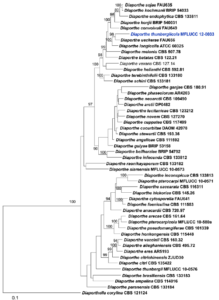Diaporthe thunbergiicola Udayanga & K.D. Hyde.
Index Fungorum Number: IF551072, Facesoffungi number: FoF00472; Fig. 1
Etymology: Referring to the original host association with tropical ornamental vine Thunbergia laurifolia Lindl.
Holotype: MFLU 14-0816
Pathogen on leaves of Thunbergia laurifolia. Sexual morph Undetermined. Asexual morph Pycnidia on alfalfa twigs on WA: subglobose to ovate, 100–200μm diam., embedded in tissue, erumpent at maturity, with an elongated, black neck 100–200μm long, often with a yellowish, conidial cirrus extruding through ostiole; walls parenchymatous, consisting of 3–4 layers of medium brown textura angularis. Conidiophores hyaline, smooth, unbranched or branched at the basal cell, ampulliform, cylindrical to sub-cylindrical, with larger basal cell 6–14×1–2μm (x±SD=11±2×1.5±0.2, n= 30). Conidiogenous cells phialidic, cylindrical, terminal, lightly tapering towards apex, 0.5–1μm diam. Paraphyses absent. Alpha conidia 5.7–7.5×2–3μm, abundant in culture and on alfalfa twigs, aseptate, hyaline, smooth-walled, ovate to ellipsoidal, biguttulate, base subtruncate (x±SD=6.6±0.4× 2.8±0.1 , n=30). Beta conidia undetermined.
Cultural characteristics: In dark at 25 °C for 1 wk, colonies on PDA fast growing, 5±0.2 mm/day (n=8), white, raised, aerial mycelium, reverse yellowish pigmentation developing in centre; stroma not produced in 1 wk old culture.
Holotype: THAILAND, Chiang Mai Province, Doi Suthep Pui herbal garden, on leaves of Thunbergia laurifolia (Acanthaceae), 10 January 2012, D. Udayanga DPH 114 (MFLU 14–0816, holotype), ex-type culture, MFLUCC 12– 0033, ICMP. GenBank ITS: KP715097; TEF: KP715098.
Notes: This is the second species described from Thunbergia laurifolia in Thailand. Udayanga et al. (2012) described Diaporthe thunbergii Udayanga, X.Z. Liu & K.D. Hyde from the same host. Both species were recovered from similar disease symptoms on leaves; however D. thunbergiicola has both abundant and distinct alpha and beta conidia. The alpha conidial dimensions overlap with other taxa in the genus, making morphological identification impossible. The fungus was associated with typical leaf spots and in latent phase of yellowing and leaf necrosis. In the phylogenetic analysis, the species was placed within D. sojae species complex (Udayanga et al. 2014), mostly consisting of crop and weed associated species. The comparison of ITS and EF1-α sequences revealed that D. thunbergiicola is distinct from the sister species D. ueckerae, originally reported from Cucumis melo L. in Oklahoma, USA. The pair-wise comparison revealed high similarities of the ITS (96 %) and EF1-α sequences (92 %) between the two species. The combined phylogenetic tree (Fig. 2) revealed the placement of D. thunbergii and D. thunbergiicola compared to a selection of closely related ex-type isolates.

Fig. 1 Diaporthe thunbergiicola (holotype) a, b Leaf sports on Thunbergia laurifolia c Pycnidia on alfalfa stem in WA d conidiophores e. alpha conidia. Scale bars:c=1000μm, d, e=8μm.

Fig. 2 Phylogram generated from RAxML based on combined alignment of ITS, TEF, β-tubulin and CAL gene regions. Maximum likelihood bootstrap support values greater than 90 % are indicated above or below the nodes. The ex-types are in bold; the newly isolate is in blue. The tree is rooted with Diaporthella corylina CBS 121124
